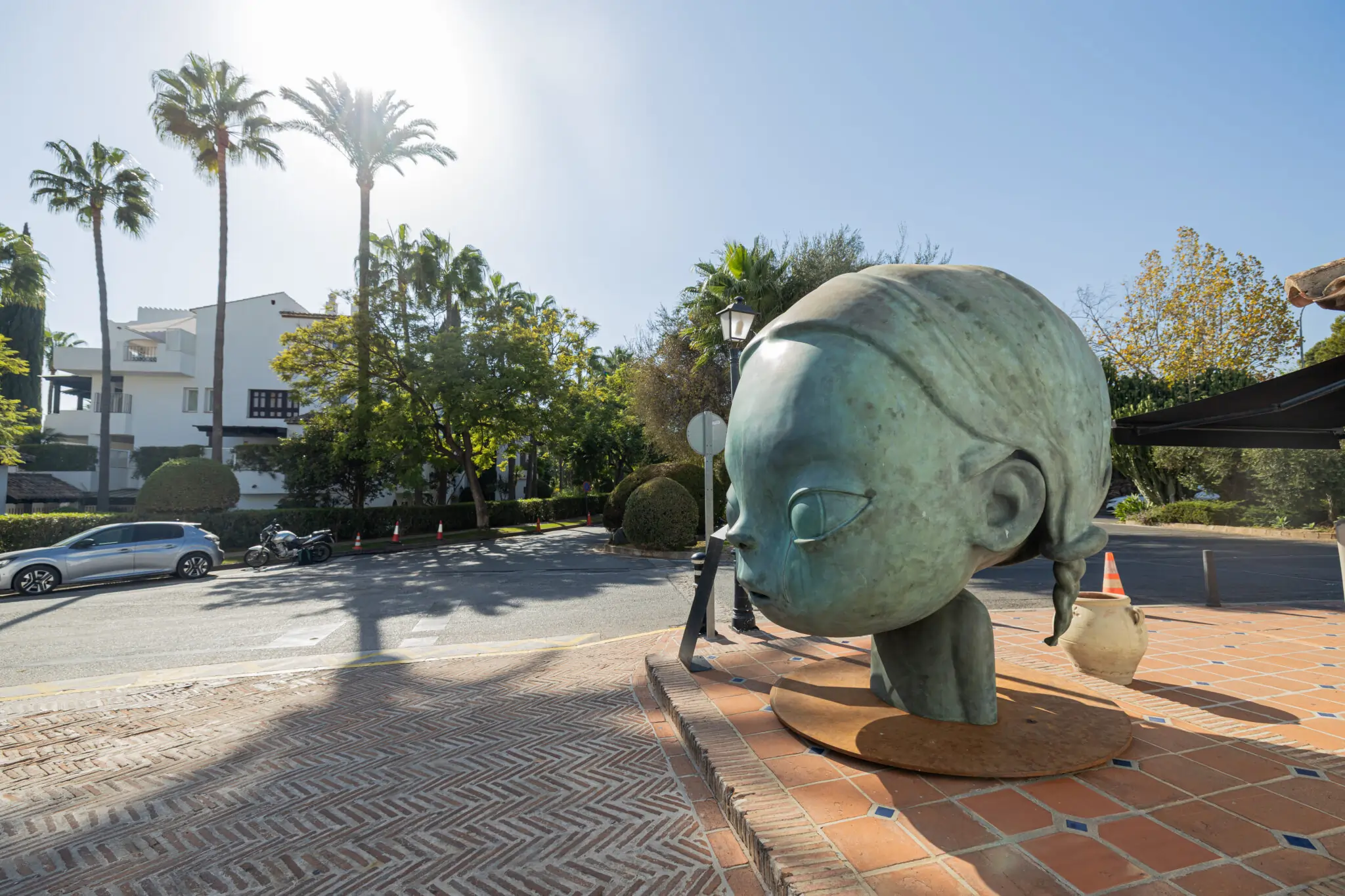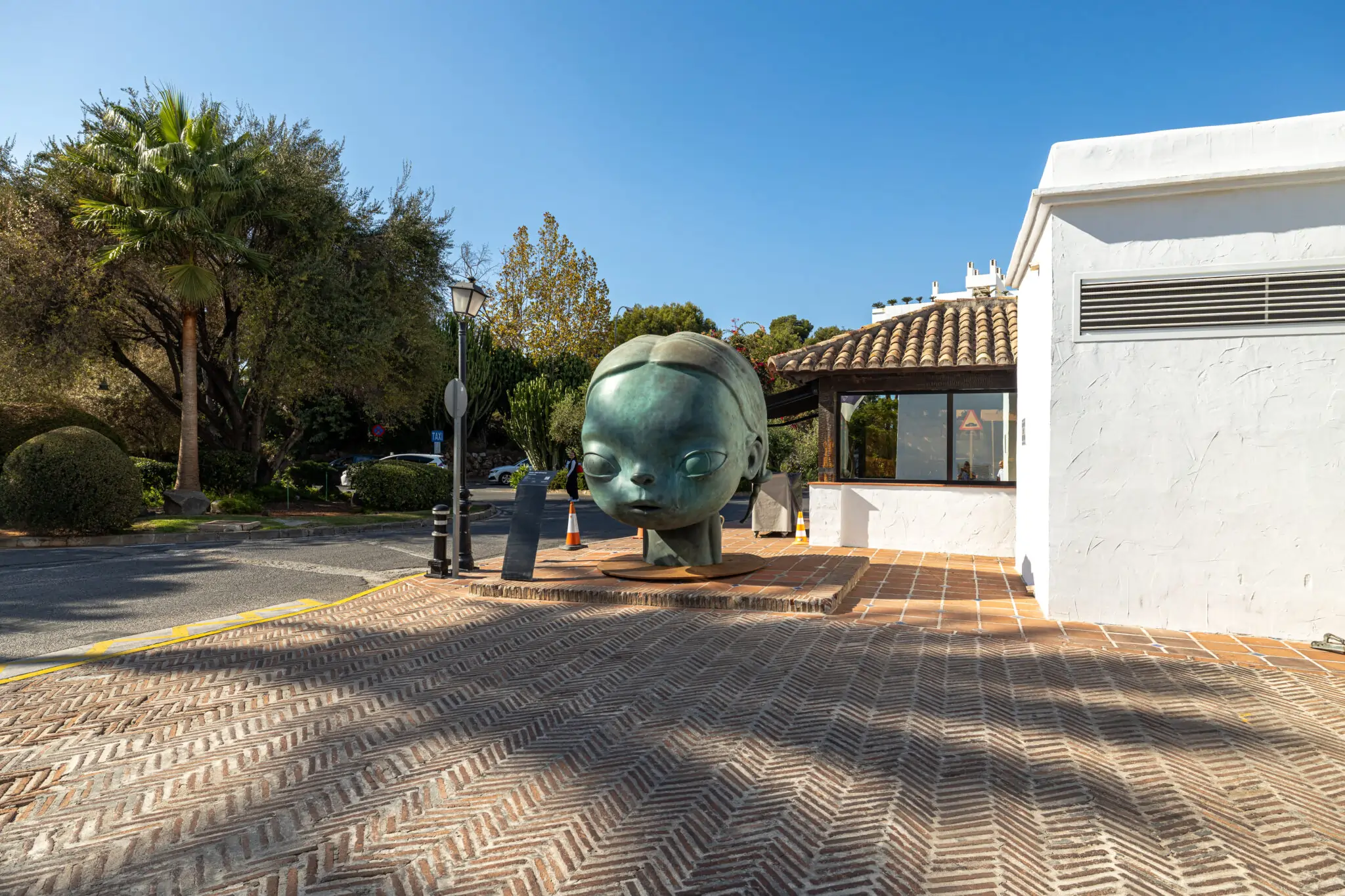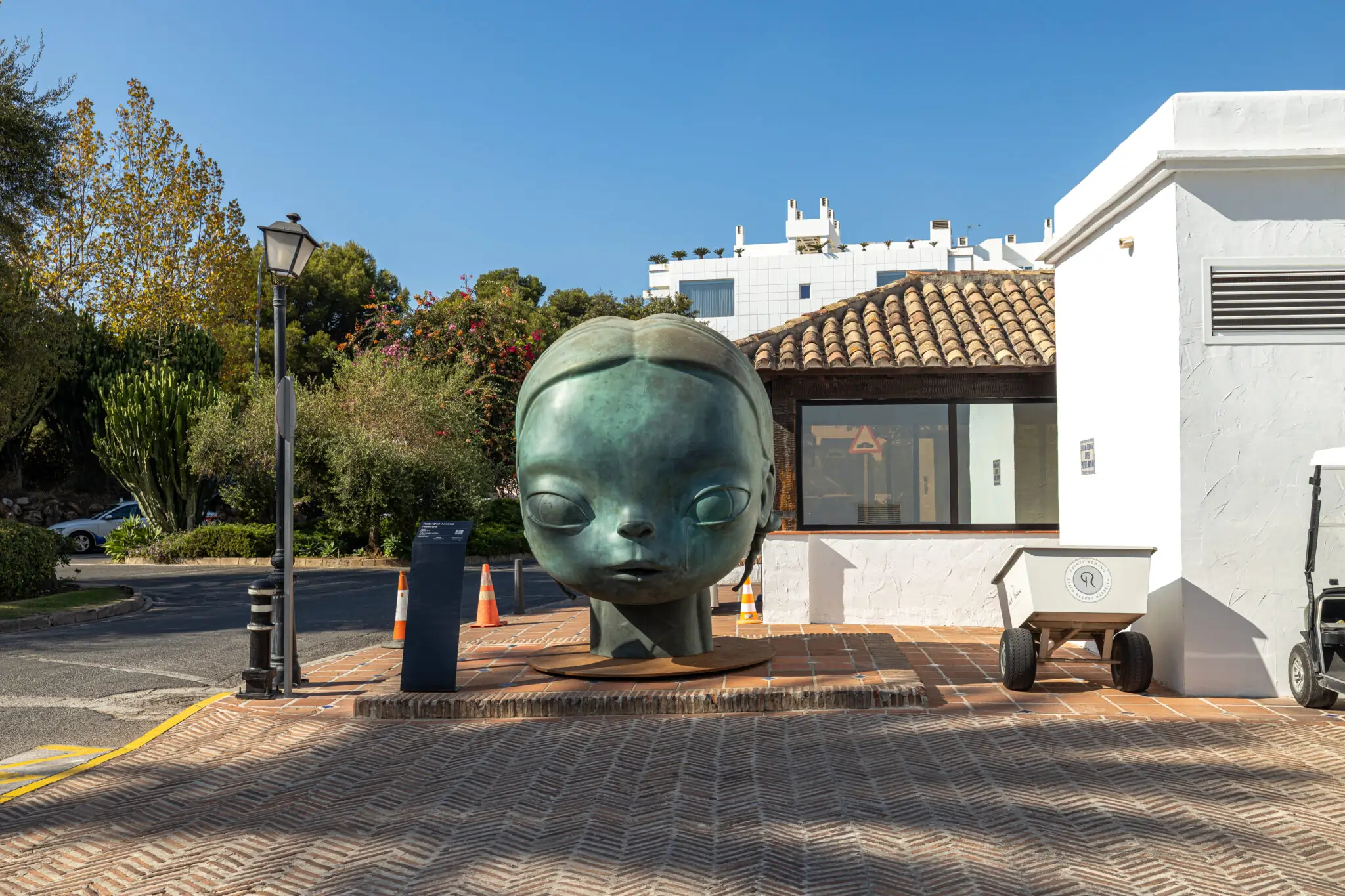
Nalakala in Marbella: A New Chapter for Public Art
Alexandra Farrell | · 10 min. read
In October 2025, the Indonesian artist Roby Dwi Antono unveiled his monumental bronze sculpture Nalakala in the gardens of the prestigious Puente Romano Hotel in Marbella, Spain. The work, which will remain on public view for at least one year, marks a new milestone in the intersection between contemporary art and public space.
This installation has already drawn international attention, not only for its striking visual presence but also for what it represents within Antono’s artistic journey and the evolving art landscape of Marbella.
The Artist and His Practice
Roby Dwi Antono, born in 1990 in Java, Indonesia, has become one of the most distinctive contemporary artists to emerge from Southeast Asia in recent years. He is primarily known for his surreal, figurative paintings, prints, and sculptures that merge personal mythology, pop surrealism, and emotional storytelling.
His visual language often features wide-eyed, dreamlike figures that seem both innocent and haunting. The childlike faces and hybrid creatures he depicts are full of subtle tension, balancing tenderness with melancholy. Through this visual vocabulary, Antono explores universal themes such as loss, nostalgia, innocence, and the fragile passage from childhood to adulthood.
While most of his early career revolved around painting and illustration, Nalakala marks a decisive step into monumental sculpture, where his imagination takes on physical form at an architectural scale. By translating his soft, surreal imagery into solid bronze, Antono bridges the gap between fantasy and permanence, emotion and endurance.
Volery Gallery, based in Dubai, has played a significant role in promoting Antono’s work to global audiences. The gallery has become known for supporting the “New Contemporary Wave,” a movement that blends the worlds of street art, pop surrealism, and fine art. Through this collaboration, Antono’s work has moved beyond gallery walls and into public spaces, making art accessible to broader audiences.
The Sculpture: Nalakala
Dimensions and Technical Details
Nalakala stands at approximately 2.75 meters in height, 2.5 meters in width, and 2.3 meters in depth. The sculpture weighs over 1.2 metric tons and was produced as part of a limited edition of three. Crafted entirely in bronze, it was cast using museum-grade precision, ensuring durability and longevity suitable for outdoor public display.
These technical details reveal the level of ambition behind the project. Antono did not create a decorative object or a temporary installation. He created a monumental work meant to withstand time, weather, and shifting contexts, symbolizing the permanence of imagination itself.

Aesthetic and Symbolic Meaning
Visually, Nalakala is unmistakably Antono. The sculpture features a large, serene face with Antono’s signature wide eyes and calm expression, suspended in a state of quiet reflection. Its surface glows with the earthy patina of bronze, which changes subtly with the light of day and the surrounding garden environment.
In many ways, the work embodies stillness. It is both childlike and cosmic, both intimate and grand. The absence of a body beneath the floating head introduces a sense of detachment, inviting viewers to contemplate inner life, memory, and identity.
Placed within the lush Mediterranean gardens of Puente Romano, the sculpture interacts with sunlight, shadows, and nature itself. The result is a dialogue between material and environment, human imagination and the organic world. In this sense, Nalakala transforms a quiet corner of Marbella into a space of reflection and gentle mystery.
Rom Levy, founder of Volery Gallery, has described Nalakala as emblematic of a broader shift in how contemporary art engages the public. Rather than confining powerful works to museums or private collections, Levy’s vision is to place them in open spaces where anyone can encounter them naturally and without mediation. Nalakala perfectly captures that ambition.
The Setting: Puente Romano, Marbella
The Venue
The Puente Romano Beach Resort is one of the most celebrated destinations on Marbella’s Golden Mile. Known for its Mediterranean architecture, lush tropical gardens, and world-class amenities, the resort has increasingly embraced art and design as key aspects of its identity. By hosting installations such as Nalakala, Puente Romano transforms its grounds into a living gallery, offering guests and visitors an immersive cultural experience.
The placement of the sculpture within the resort’s gardens is intentional. It situates the artwork between public and private realms, accessible to visitors but still surrounded by a sense of tranquility and exclusivity. Guests may encounter the sculpture by surprise as they walk through the gardens, dine outdoors, or relax by the water, creating an experience of spontaneous discovery.
The Mediterranean light plays a crucial role in how the sculpture is perceived. Throughout the day, shadows move across the bronze surface, altering its mood and color. Morning light accentuates its softness and warmth, while the setting sun gives it a deeper, more introspective tone. At night, subtle illumination highlights its contours, giving Nalakala a sense of quiet, almost spiritual presence.
Marbella’s Relationship with Art
Marbella, long known for its luxury lifestyle and tourism, has recently been developing a stronger identity as a city of art and culture. While it has historically been home to private collections and smaller galleries, the city has seen a growing emphasis on integrating art into its public spaces. The installation of Nalakala at Puente Romano represents a significant step in this direction.
It shows that Marbella can serve not only as a playground for leisure but also as a platform for global artistic expression. The city’s combination of affluence, natural beauty, and international visitors creates fertile ground for cultural projects that blend luxury with creativity.
In this context, Nalakala is not just a sculpture but a symbol of Marbella’s evolution as an art destination. It bridges the gap between local culture and the global art scene, aligning the city with other world-class destinations that integrate art into everyday environments.
From Ibiza to Marbella: The Journey of Nalakala
Before arriving in Marbella, Nalakala made its debut in Ibiza during the summer of 2024, where it was installed at the city’s famous Passeig de Vara de Rey as part of the CAN Art Fair. In Ibiza, it was displayed in a highly public setting, surrounded by locals, tourists, and art enthusiasts, creating a dialogue between contemporary sculpture and urban life.
After the success of that exhibition, the sculpture was transported to Marbella for a longer, more permanent stay. This move represents more than a logistical relocation. It reflects a conceptual shift—from the vibrant, fast-paced energy of Ibiza to the more reflective and luxurious ambiance of Marbella.
In Ibiza, Nalakala stood as a bold statement amid the bustle of a lively summer art scene. In Marbella, it becomes something else—a meditative presence that invites quiet contemplation rather than excitement. The contrast between the two locations deepens the work’s meaning, showing how context transforms perception.
The Meaning of Nalakala
The word Nalakala itself carries poetic resonance, though Antono has not offered a definitive explanation of its origin. Like much of his work, the title leaves space for imagination. It could refer to a mythical being, a dream state, or simply a name born of intuition.
The ambiguity of the title mirrors the sculpture’s visual mystery. Antono’s practice often draws from Indonesian folklore, myth, and childhood memories, translating them into universal symbols. The large head of Nalakala may represent introspection, the inner child, or the timeless human urge to create meaning from the unknown.
By making the face monumental, Antono elevates inner emotion to the scale of architecture. The work becomes a temple of thought, a place where the viewer is invited to project their own emotions and stories.

Broader Implications
Redefining Public Art
Nalakala challenges conventional ideas about public sculpture. Traditional monuments often commemorate historical events or figures, but Nalakala commemorates emotion, imagination, and wonder. It does not tell viewers what to think. Instead, it invites them to feel and interpret freely.
By situating this work in a semi-public luxury space, Volery Gallery and Antono blur the boundaries between private art and civic experience. This approach makes art accessible in new ways, integrating it into daily life rather than isolating it in museums.
Southeast Asian Voices in Global Art
Roby Dwi Antono’s success reflects the growing presence of Southeast Asian artists on the world stage. His rise represents a broader cultural shift, as artists from Indonesia, Thailand, Vietnam, and the Philippines gain international recognition.
Antono’s art speaks a global visual language but carries the depth and storytelling tradition of his Indonesian heritage. By installing Nalakala in a European setting, the artist symbolically bridges continents, cultures, and histories.
This cultural exchange is vital. It shows how global art no longer flows in one direction, from West to East, but circulates in a dynamic, interconnected way that enriches everyone involved.
Material, Time, and Sustainability
Creating a monumental bronze sculpture is both an artistic and environmental decision. Bronze is durable and can last centuries, but it also demands great care. Exposure to sun, rain, and humidity changes the material over time, developing a living patina that becomes part of the sculpture’s story.
While there is no public information on the conservation plan for Nalakala, it is clear that maintaining such a piece will require collaboration between the gallery, the venue, and conservation specialists. This commitment to preservation ensures that the work will continue to inspire future generations.
A Symbol for Marbella’s Future
The arrival of Nalakala signals more than the presence of a beautiful sculpture. It represents Marbella’s growing role as a meeting point between art, culture, and innovation. The piece stands quietly, yet powerfully, as an emblem of what contemporary public art can achieve when vision, craftsmanship, and context align.
It also offers an example of how luxury spaces can take responsibility for supporting culture, giving back to the community through access to meaningful artistic experiences. For Marbella, this installation could pave the way for future collaborations, making art an integral part of the city’s identity.
Nalakala transcends categories
Nalakala is a work that transcends categories. It is monumental yet intimate, surreal yet grounded, foreign yet universally human. Standing amid the lush gardens of Puente Romano, it connects past and present, myth and material, imagination and reality.
For Roby Dwi Antono, it marks a new chapter in his artistic journey, translating the inner world of his paintings into enduring sculptural form. For Marbella, it marks a new era in its cultural story—a moment when art, beauty, and place come together in harmony.
In the end, Nalakala reminds us that public art is not just decoration. It is dialogue, memory, and the living pulse of imagination shared in common space.